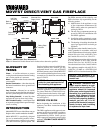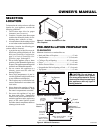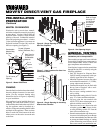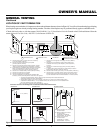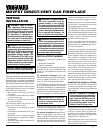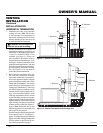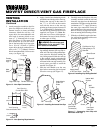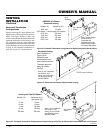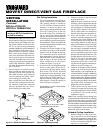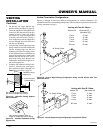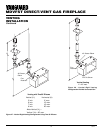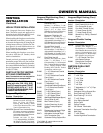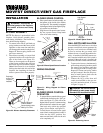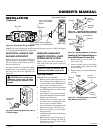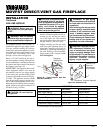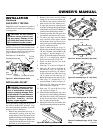
10
106442
MDVFST DIRECT-VENT GAS FIREPLACE
®
4. Connect a section of pipe and extend
up through the hole.
Note:
If an offset is needed to avoid ob-
structions, you must support the vent pipe
every 3 feet. Use wall straps for this pur-
pose (see Figure 21). Whenever possible,
use 45° elbows instead of 90° elbows.
The 45° elbow offers less restriction to
the flow of the flue gases and intake air.
5. Place the flashing over the pipe
section(s) extending through the roof.
Secure the base of the flashing to the
roof and framing with roofing nails. Be
sure roofing material overlaps the top
edge of the flashing as shown in Figure
21. There must be a 1" clearance from
the vent pipe to combustible materials.
When installing the flashing on a metal
roof we require that putty tape is used
between the flashing and the roof. The
flashing must be secured to the roof us-
ing #8 x 3/4" screws and then sealed
with roof coating to prevent leakage
through the screw holes. A roof coat-
ing must also be applied around the pe-
rimeter to provide a proper seal.
6. Continue to add pipe sections until the
height of the vent cap meets the mini-
mum building code requirements de-
scribed in Figure 10 on page 5.
Note
: You
must increase vent height for steep roof
pitches. Nearby trees, adjoining rooflines,
steep pitched roofs, and other similar fac-
tors may cause poor draft or down-draft-
ing in high winds. Increasing the vent
height may solve this problem.
7. Twist-lock the vent cap onto the last
section of vent pipe and seal outer pipe
with high temperature silicone sealant
as specified in the second warning
statement on page 6.
Note:
If the vent pipe passes through any
occupied areas above the first floor, including
storage spaces and closets, you must enclose
pipe. You may frame and sheetrock the enclo-
sure with standard construction material. Make
sure and meet the minimum allowable clear-
ances to combustibles. Do not fill any of the
required air spaces with insulation.
Cathedral Ceiling Installation
1. Remove shingles or other roof cover-
ing as necessary to cut the rectangular
hole for the support box. Mark the out-
line of the cathedral ceiling support box
on the roof sheathing using the locat-
ing hole as a center point.
1. Determine the route your vertical vent-
ing will take. If ceiling joists, roof rafters,
or other framing will obstruct the vent-
ing system, consider an offset (see Fig-
ure 21) to avoid cutting loadbearing
members.
Note:
Pay special attention to
these installation instructions for re-
quired clearances (air space) to combus-
tibles when passing through ceilings,
walls, roofs, enclosures, attic rafters, etc.
Do not pack air spaces with insulation.
Also note maximum vertical rise of the
venting system and any maximum hori-
zontal offset limitations. Offsets must
fall within the parameters shown in Fig-
ure 10 on page 5.
2. Set the fireplace in desired location.
Drop a plumb line down from the ceil-
ing to the position of the fireplace exit
flue. Mark the center point where the
vent will penetrate the ceiling. Drill a
small locating hole at this point.
Drop a plumb line from the inside of
the roof to the locating hole in the ceil-
ing. Mark the center point where the
vent will penetrate the roof. Drill a
small locating hole at this point.
Flat Ceiling Installation
1. Cut a 10" square hole in the ceiling us-
ing the locating hole as a center point.
The opening should be framed to
10"x10" (254mm x 254mm) inside di-
mensions, as shown in Figure 14 on
page 8 using framing lumber the same
size as the ceiling joists. If the area
above the ceiling is an insulated ceil-
ing or a room, nail firestop from the
top side. This prevents loose insulation
from falling into the required clearance
space. Otherwise, install firestop below
the framed hole. The firestop should be
installed with a minimum of three nails
per side (see Figure 21).
2. Assemble the desired lengths of pipe
and elbows necessary to reach from the
fireplace flue up through the firestop.
All connections must be sealed with
high temperature silicone sealant as
specified in the second warning state-
ment on page 6. Be sure all pipe and
elbow connections are fully twist-
locked (see Figure 13, page 8).
3. Cut a hole in the roof using the locating
hole as a center point. (Cover any ex-
posed open vent pipes before cutting
hole in roof.) The 10"x10" hole must
be measured on the horizontal; actual
length may be larger depending on the
pitch of the roof. There must be a 1"
clearance from the vent pipe to combus-
tible materials. Frame the opening as
shown in Figure 14 on page 8.
VENTING
INSTALLATION
Continued
Figure 21 - Offset with Wall Strap and 45
°
45° Elbow
Wall Strap
Roof
Flashing
Ceiling Firestop
Figure 22 - Installing Firestop
If area above is not a room, install
firestop below framed hole.
If area above is a room, install firestop
above framed hole.
INSTALLATION FOR
VERTICAL TERMINATION
NOTICE: Use rigid pipe only. Flex
venting is NOT to be used with a
vertical termination.



